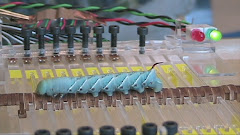 A couple of years back, I was deeply impressed by probably the most well-known bio-inspired robot which demonstrated the effects of central pattern generator on gait transitions. This is the EPFL salamander robot with coupled non-linear oscillators. In this research amphibious robot, smooth gait transitions were accomplished by tuning the gain of oscillators coupling.
A couple of years back, I was deeply impressed by probably the most well-known bio-inspired robot which demonstrated the effects of central pattern generator on gait transitions. This is the EPFL salamander robot with coupled non-linear oscillators. In this research amphibious robot, smooth gait transitions were accomplished by tuning the gain of oscillators coupling.As I started working on soft-bodied robots, I discovered that many non-linear characteristics of the soft materials and actuators can be exploited to engineer behaviors. So I took a completely different approach to robot control. Instead of programming complex behaviors on a micro-processors, I "tuned" the body and actuators so they create desirable behaviors when I switch on a behavioral circuit. Amazingly, when the motor variations and body properties reach a certain domain, the robot was able to achieve gait transitions with a simple scaling of motor-pattern. This is a very intriguing demonstration because it provokes a rather radical inquiry: how much logic/intelligence can we embed in a piece of material? To what extent can we use morphing morphologies to perform computation (or thinking if you will)?

.jpg)
No comments:
Post a Comment